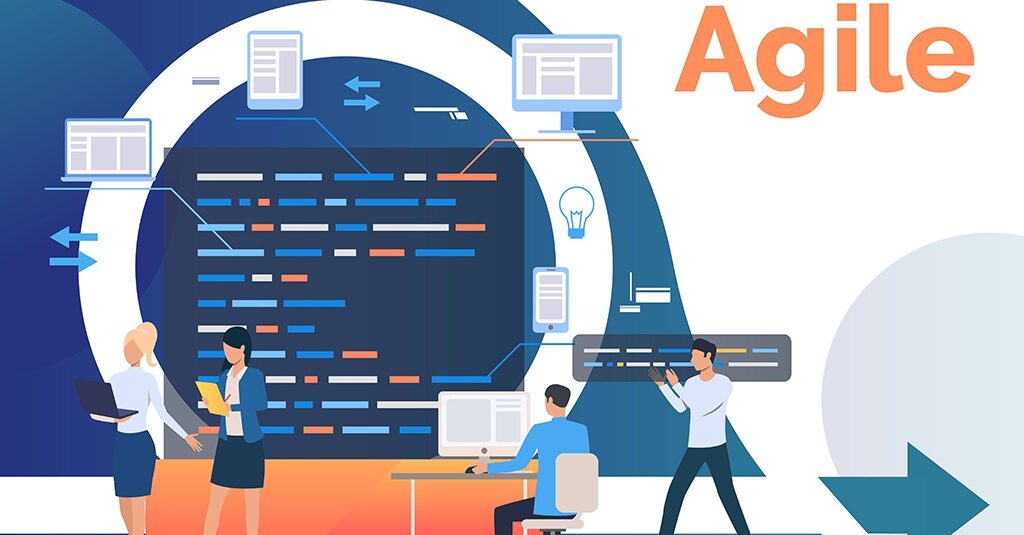Agile software development, some points all must know to grow together… Examples of Agile Methodology. The most popular and common examples are Scrum, eXtreme Programming (XP), Feature Driven Development (FDD), Dynamic Systems Development Method (DSDM), Adaptive Software Development (ASD), Crystal, and Lean Software Development (LSD). Teams generally pick one or two methods.
Agile is most appropriate on any urgent project with significant complexity and novelty. “Agile” term is a continuous process of working at each level to improve the project or task for a fruitful/ progressive outcome. Let go ahead to start the learning now…

Agile methodology
Agile methodology is a way of distributing a task in several steps to avoid major waste and boost beneficial progress to satisfactory outcome in project management.
Here a team works in collaboration and is planning as per requirement, changes can be made at any level as the aspect is clear and open for all.

This promotes teamwork, courage, self organizing behavior, discipline and responsibility.
This methodology leads to time as well as money profits. As the pre-planning and regular updates helps in reducing project failure and increases predictability, productivity, quality, flexibility, visibility with high rate of client satisfaction. Also, helps the team to boost morale.
This Benefits to:
Customer : Full satisfaction with all point of requirement
Developer : Productive working and reduction in re-working for same concerns
Scrum Master : Regular tracking at each level of tasks/projects leads to analyzing issues in less time and effective resulting with better awareness
Product Owner : Planning and working done as per customer need, maximum value for deliveries and frequent opportunity to re-priorities the work as per scenarios
Agile Manifesto
Agile Manifesto is a report that outlines the values and principle to be used in working organizations to grow together with high rate of success, and avoiding unproductive working to manage organizations major to minor projects and working process.

Principles behind the Agile Manifesto
The four guiding principle/pillars of Agile programming advancement as expressed by the Agile Manifesto are:
Individuals and interactions over processes and tools
People in an organization are the most valuable asset before software, as software can be used by the people to generate outcomes and people feel relaxed while talking with each other. During the interaction process each one shares new ideas as the perspectives are not the same for all at all points. Communication is the best way to share ideas and build better relationships along with a best product outcome.
Working software over comprehensive documentation
Before Agile was fully practiced, the team needed to prepare a good number of documents including requirements, specifications, and many more things and was a long time procedure occupying a good amount of productive time.
These are to be planned in the beginning under Agile with a regular tracking process before the task is to be performed. In this way, the developer or team have a user story (brief of customer’s need and predicted result; eg: “As [persona], I want to [action], so that I can [benefit].”) and can cover all points to speedup the working till delivery in given period of time.

Customer collaboration over contract negotiation
Previously, the customer’s role was to share and discuss the needs and wants and the re-negotiations were to be made later if the project’s timeline expires. In this way, the collaboration of the customer in the development cycle is almost nil.
As per Agile manifesto, taking customer’s in the development cycle and asking them with their suggestions and opinion on the project regularly keeps the customer engaged in the project and lends to the delivery as it is required by them. Practicing this will also help the team/ organization to get more ideas to execute in other fields and make you irreplaceable and recallable for other projects as well.
Responding to change over following a plan
The traditional methodology was to make as little changes as possible in a smooth way with a linear path, recognizing that it may cost both time and money. While in Agile, it is a rigid process and the execution helps people in making them ready for new roles, possibilities and responsibility along with working improvement. Agile works in breaking task to small & proceed with regular tracking, and so the changes can improves the management process and catch issues quickly.
Basic 12 Principles by the Agile Manifesto are:

- Our highest priority is to satisfy the customer through early and continuous delivery of valuable software
Client satisfaction – high priority - Welcome changing requirements, even late in development. Agile processes harness change for the customer’s competitive advantage.
Changes are welcomed at any level of development as the client is the part of development and can share the competitive requirements at any time - Deliver working software frequently, from a couple of weeks to a couple of months, with a preference to the shorter timescale.
Agile work by making long projects in many short sprints(sub tasks) and so delivery on regular period of time is assured from weeks to months
- Business people and developers must work together daily throughout the project.
Interaction and collaborations are the two most important keys in Agile, as it minimizes the rate of confusion and helps in making goals to be aligned for all without much failure
- The process builds projects around motivated individuals, giving them the environment and support they need, and trusts them to get the job done.
When team is correctly aligned and right person is assigned for the specific tasks, the result will be delivered as was desired
- A face-to-face conversation is the most efficient and effective method of conveying information to and within a development team.
Discussion boosts the team and helps in breaking many types of barriers. Face to face discussion is best for 100% satisfactory result and Zoom/G-meet are the great platform to proceed for remote working situations
- Working software is the most important measure of progress.
Delivery of software/projects with High-quality working is major goal to keep client satisfied is best achievement
- Agile processes promote sustainable development. The sponsors, developers, and users should maintain a constant pace indefinitely.
Consistency and focus are much needed in Agile to get the expected goal.
- Pay continuous attention to technical excellence, and good design enhances agility.
Making required delivery is not the only desire in Agile Methodology, one need to know, learn and innovate regularly to bring new updates and advantage to make things from better to the best
- Simplicity is essential. This is the art of maximizing the amount of work not done.
Continues working is much required but the working should also be generating good as well as real values to your skills and projects
- Self-organizing teams produce the best architectures, requirements, and designs.
Single person can handle a task and make the delivery but making a team promotes teamwork and helps the project to make it done in less time with more effective features along with a variety of ideas came out during the project development cycle
- At regular intervals, the team reflects on how to become more effective and adjusts its behavior accordingly.
Daily sprint is much beneficial as the issues can be cured before they reach the worst case. Also, by this, each of the team will groom their skills on regular basis to get better to best opportunity and responsibility
I hope this article will be helpful for you... If found so don't forget to share with your friends, groups and teammates... More points are planned to be published soon, so stay connected and also suggest your topics where we may help you further...






Kamel
Nice one
Annie
Good Info
Annie
Great update… much needed man!!
Mannat Srivastava
Informative ??
Jose
Amazing bro… Waiting for the next details now…